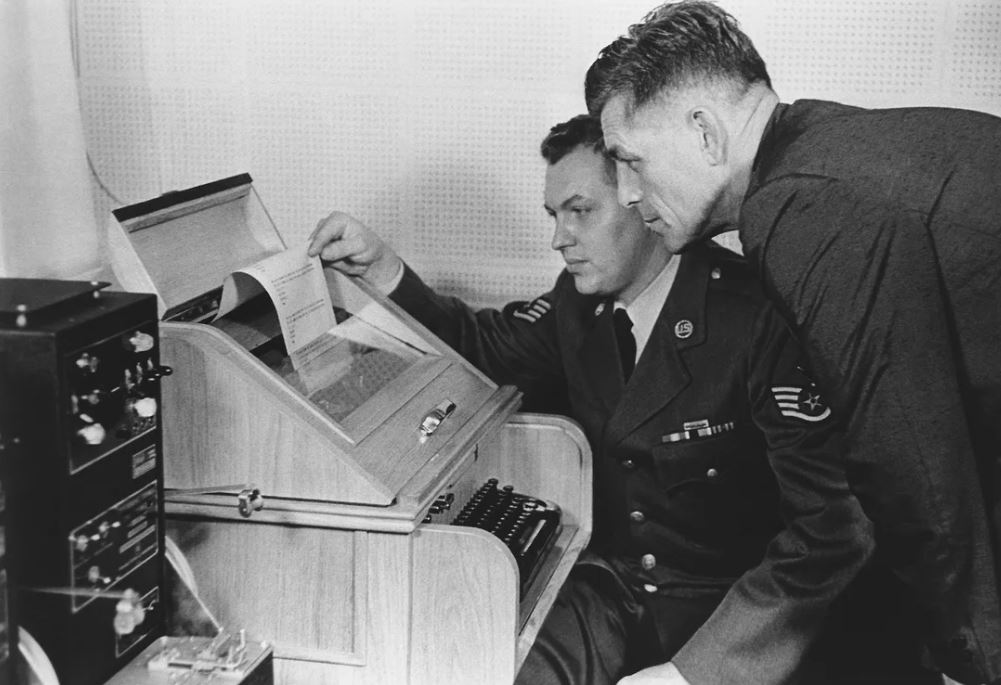In 1963, shortly after the Cuban Missile Crisis, the USSR and the United States agreed to create a direct channel of communication between top leaders to reduce the risk of a nuclear conflict. The channel remains operational and is tested every hour.
Brown fox and fake specimen
The need to organize a hotline of communication between the leaders of the United States and the USSR arose after the Cuban Missile Crisis of 1962.
At that time, the transmission and decoding of messages through official diplomatic channels took from 6 to 13 hours – an unacceptably long time, given that the world was on the brink of nuclear war.
In the summer of 1963, negotiations began to control nuclear weapons and expand contacts between the two countries.
“The first step in this direction will be to reach an agreement on direct communication between Moscow and Washington in order to avoid on both sides dangerous delays, misunderstandings and misinterpretations of actions that may take place during a crisis,” the US President said on June 10, 1963 John Kennedy.
Ten days later, the official representatives of the United States and the USSR in the Disarmament Committee, Charles Still and Semyon Tsarapkin, signed a memorandum “on the establishment of a direct line of communication.”
It is interesting that the original author of this idea was not a statesman, but a journalist – the editor-in-chief of the American magazine Parade, Jess Gorkin, who called for the creation of a hotline in case of emergency in an open letter back in 1960.
Gorkin’s contribution was later recognized by US President John Kennedy, who recognized the journalist with a letter of gratitude.
On August 30, 1963, the first hotline message arrived from Washington to Moscow: “The quick brown fox jumped over the lazy dog’s back 1234567890” – “The quick brown fox jumped over the lazy dog’s back.”
This pangram phrase contains all the characters of the Latin alphabet and is used for testing equipment. In response, Moscow also sent a pangram with all the symbols of the Cyrillic alphabet: “Would citrus live in the thickets of the south? Yes, but a fake copy! 1234567890.”
From that day until now, to ensure instant availability in a crisis situation, every odd hour a test message in Russian is sent from Moscow to Washington, and every even hour a test message is sent back in English.
The texts are neutral: most often they are fragments from classic works and popular science articles.
Indirect line
Thanks to cinema, one of the stereotypes about the Cold War emerged: in a crisis situation, the leader of one country personally calls his colleague on a telephone, usually a red one.
In fact, voice contact was excluded in emergency cases – it carried the risk of incorrect translation, while written contact gave time to comprehend the information. Messages were transmitted via cable channel using teletypes – electromechanical printing machines.
The channel was not direct – it passed through an undersea transatlantic cable through London, Copenhagen, Stockholm and Helsinki. The agreement between the countries stipulated that “if experience shows the need for an additional wire circuit, it may be installed by mutual agreement.”
Such a need soon arose: in 1964, a thief cut off a section of cable near Helsinki, and in 1965, a Finnish farmer accidentally cut the cable. A year later, he was damaged by a Soviet cargo ship that ran aground in Denmark.
In addition to cable, teletypes were connected by radio to a point in Moroccan Tangier, an autonomous international economic and political territory. The messages were duplicated across three channels and were considered correct only if at least two completely coincided.
Since 1978, countries began to use satellite communication channels – the cable channel became a backup, and the radio channel stopped working.
American military and Soviet telegraph operators
The line became the first channel in the world specifically designed to discuss crisis situations between conflicting states.
Later, according to the same scheme, Moscow connected with Paris, London, Pyongyang and Beijing. The experience of the USSR was followed by India and Pakistan, South and North Korea.
What is unique is not so much the line itself from a technical point of view, but the service and operating protocol built around it. Not only technical specialists, but also translators are constantly on duty at the terminals; quick and direct access is provided for the leadership of countries.
According to declassified data, six teams of two people each work on the hotline in the United States (a signalman and an interpreter).
Also on the line is one presidential interpreter, who, on occasion, can give a more detailed interpretation of specific formulations, taking into account the political situation. Information about the number of employees from the Soviet and Russian sides is classified.
Interestingly, on the US side, most of the employees were military men, while on the Soviet side women often served – experienced telegraph operators who knew how to work at the keyboard with metronomic accuracy.
The hotline terminal in Moscow moved several times. In the early years, it was located in the Central Telegraph building on Gorky Street (now Tverskaya Street); later it moved to the Kremlin, where it also changed premises several times.
There are several terminals in the United States: in the basement of the Pentagon, in the White House and in the Raven Rock mountain complex in Pennsylvania.
The principle of one-time pads
In the early years, the USA and the USSR fundamentally did not use devices of their own production in order to adhere to neutrality – the Norwegian ETCRRM II encryption machine was installed on the line, and a teletype was directly connected to it.
The parties provided each other with their own sets of teleprinters and everything necessary for their operation free of charge.
The USSR ordered teletypes with a Cyrillic keyboard first from the GDR (T63 SU12), and later from the Czech Republic (Siemens T-100S).
Messages are encrypted using the Vernam cipher, which is characterized by absolute cryptographic strength. To send a message, you need to have a secret key, which exists only in two copies.
When transmitting, the text was first converted into a five-bit code and, using an encryption machine, combined with a key – a random sequence of bits printed on paper punched tape. The machine deciphered the transmitted message in real time.
In 1985, microprocessors replaced encryption machines, and punched tapes replaced 5.25-inch floppy disks, but the principle of encryption remained. Communication keys were supplied by diplomatic mail through embassies.
After use, the punched tape or floppy disk was destroyed. Thus, the “one-time pad principle” was supported.
In 1990, a telephone line was installed for the first time – DVL (direct voice link), and since 2008 a video communication line has appeared. On December 7, 2021, Presidents Vladimir Putin and Joe Biden discussed it for the first time.
However, both of these channels do not belong to the hotline, but only complement it. The current presidents, according to official data, did not use the hotline, however, as the press secretary of the Russian President Dmitry Peskov said in February 2022, “they can use it if they wish.”




















